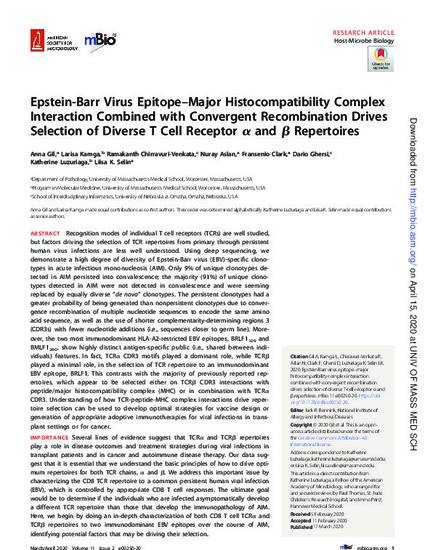
Recognition modes of individual T cell receptors (TCRs) are well studied, but factors driving the selection of TCR repertoires from primary through persistent human virus infections are less well understood. Using deep sequencing, we demonstrate a high degree of diversity of Epstein-Barr virus (EBV)-specific clonotypes in acute infectious mononucleosis (AIM). Only 9% of unique clonotypes detected in AIM persisted into convalescence; the majority (91%) of unique clonotypes detected in AIM were not detected in convalescence and were seeming replaced by equally diverse "de novo" clonotypes. The persistent clonotypes had a greater probability of being generated than nonpersistent clonotypes due to convergence recombination of multiple nucleotide sequences to encode the same amino acid sequence, as well as the use of shorter complementarity-determining regions 3 (CDR3s) with fewer nucleotide additions (i.e., sequences closer to germ line). Moreover, the two most immunodominant HLA-A2-restricted EBV epitopes, BRLF1109 and BMLF1280, show highly distinct antigen-specific public (i.e., shared between individuals) features. In fact, TCRalpha CDR3 motifs played a dominant role, while TCRbeta played a minimal role, in the selection of TCR repertoire to an immunodominant EBV epitope, BRLF1. This contrasts with the majority of previously reported repertoires, which appear to be selected either on TCRbeta CDR3 interactions with peptide/major histocompatibility complex (MHC) or in combination with TCRalpha CDR3. Understanding of how TCR-peptide-MHC complex interactions drive repertoire selection can be used to develop optimal strategies for vaccine design or generation of appropriate adoptive immunotherapies for viral infections in transplant settings or for cancer.
IMPORTANCE Several lines of evidence suggest that TCRalpha and TCRbeta repertoires play a role in disease outcomes and treatment strategies during viral infections in transplant patients and in cancer and autoimmune disease therapy. Our data suggest that it is essential that we understand the basic principles of how to drive optimum repertoires for both TCR chains, alpha and beta. We address this important issue by characterizing the CD8 TCR repertoire to a common persistent human viral infection (EBV), which is controlled by appropriate CD8 T cell responses. The ultimate goal would be to determine if the individuals who are infected asymptomatically develop a different TCR repertoire than those that develop the immunopathology of AIM. Here, we begin by doing an in-depth characterization of both CD8 T cell TCRalpha and TCRbeta repertoires to two immunodominant EBV epitopes over the course of AIM, identifying potential factors that may be driving their selection.
- EBV,
- Epstein-Barr virus,
- T cell receptor,
- TCR,
- acute infectious mononucleosis,
- repertoire,
- UMCCTS funding
Gil A, Kamga L, Chirravuri-Venkata R, Aslan N, Clark F, Ghersi D, Luzuriaga K, Selin LK. Epstein-Barr Virus Epitope-Major Histocompatibility Complex Interaction Combined with Convergent Recombination Drives Selection of Diverse T Cell Receptor α and β Repertoires. mBio. 2020 Mar 17;11(2):e00250-20. doi: 10.1128/mBio.00250-20. PMID: 32184241; PMCID: PMC7078470. Link to article on publisher's site
Available at: http://works.bepress.com/dario-ghersi/25/
